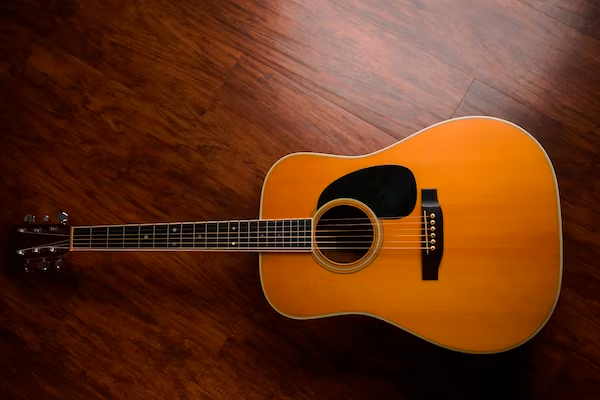
Welcome to our blog post all about guitar string gauges. Whether you’re a seasoned guitar player or just starting, understanding the importance of string gauge is essential for achieving the gauge is best sound and playability on your guitar. In this article, we’ll cover everything you need to know about guitar string gauges, how to measure them, and why it matters. String gauge on guitar is an important topic that every guitarist should be familiar with. Choosing a set of guitar strings is simple when you know what you’re looking for, and you probably won’t change much once you’ve settled on the right ones.
In this blog post, we will explore the significance of replacing your strings with the same gauge, discuss if guitar string gauge is measured in mm, address whether 13 gauge strings are hard to play, explain why string gauge matters, recommend measuring devices for gauging your guitar strings, provide some useful tips and warnings, and conclude with some final thoughts.
Table of Contents
What are String Gauges on Guitar?
First things first, what exactly are string gauges on a guitar? String gauge refers to the thickness or diameter of the individual strings on your guitar. It is typically measured in thousandths of an inch or millimeters. Different guitar string gauges produce different tones and playability, allowing you to customize your sound and feel. They are typically measured in thousandths of an inch and are denoted by a number is the gauge. For example, a 10-gauge string is 0.010 inches thick.
String gauge is commonly categorized by the size of the thinnest string, known as the high E string. For example, a set of 9-gauge strings means that the high E string has a diameter of 0.009 inches.
How Do You Tell What Gauge your Guitar Strings are?
To determine the gauge of your guitar strings, you can refer to the packaging or labeling of the strings themselves. Most string manufacturers indicate the gauge on the packaging of String packs, making it easy to identify. Additionally, you can use a string action gauge, caliper, or micrometer to measure the thickness of the strings.
Additionally, the gauge of the thickest string, usually the low E string, is often mentioned in string sets as the reference point.
How to Measure Guitar String Gauge?
The most accurate way to measure the gauge is by using a string action gauge. This tool allows you to accurately measure the thickness of each string. Simply place the gauge against the string, and it will display the gauge measurement. It’s an indispensable tool for any guitarist who wants to know the precise gauge of their strings.
You can use a string action gauge, caliper, or micrometer to measure the thickness of each string. This will give you a precise measurement that can help you select the right gauge for your playing style.
When measuring string gauge, it’s important to note that the gauge is measured at the 12th fret, which is the midpoint of the string length. Start by loosening the string and sliding the gauge underneath until it touches the bottom of the string. Then, tighten the string and check the measurement on the gauge. Repeat this process for every string on your guitar to ensure consistency.
The Importance of Replacing to the Same Gauge
Selecting the right gauge for your guitar is determined by a combination of factors, including your playing style, genre, and the sound you’re trying to achieve.
Now that you know what gauge your strings are, it’s crucial to replace them with the same gauge when the time comes. Now that we’ve covered the basics, let’s explore why string gauge matters. When it comes to changing the gauge my guitar strings, it’s generally I select to stick with the same gauge that the guitar is set up for. This is because different gauges can affect the tension on the neck, bridge, and overall playability of the instrument.
If you’re accustomed to a light string gauge, switching to a thicker gauge might make it harder to play and achieve those big string bends. Thicker strings, such as heavy gauge strings, produce a fuller and warmer tone, while thinner strings, like light gauge strings, produce brighter and more treble-focused sounds. The choice of string gauge depends on personal preference and the style of music you play.
Light string set gauges, such as size 9 guitar strings, are commonly preferred by many guitarists.
Different guitar types may require different string gauges as well. Acoustic guitars generally have thicker strings to produce more volume and resonance, while electric guitars often use lighter gauge strings for easier bending and faster playing. It’s important to experiment and find the gauge that suits your playing style and desired sound. The most common you’ll encounter are 9s, 10s and 11s. Some brands give generic names to their string sets like light, medium, or heavy.
When selecting a set of strings, you will come across various string gauge combinations and brands. Each string gauge combination offers a unique balance of tension and tone. For example, a set of 10-gauge strings might have a thicker wound 6th string for a fuller tone, while the 1st string remains thinner for easier bending.
Is the Guitar String Gauge in mm?

Image by Krzysztof Hepner from Unplash
Yes, guitar string gauges can be measured in millimeters as well. While most guitar string packages use the standard inch measurements, some manufacturers provide measurements in millimeters. Both measurements serve the same purpose in determining the thickness of the strings.
Are 13 Gauge Strings Hard to Play
Thick strings, such as 13 gauge, can be challenging to play, especially for beginners or players with smaller hands. These strings require more finger pressure to fret and bend, making certain techniques more challenging. However, some guitarists prefer the tone and sustain that thicker strings provide.
Why String Gauge Matters
String gauge refers to the thickness of the strings on your guitar. The gauge of a guitar string can greatly affect your playing experience and the sound you produce. It’s important to understand that string gauge is not a one-size-fits-all concept. Different players have different preferences, and it ultimately comes down to finding the gauge that suits your playing style and sound preferences.
Lighter strings offer a brighter tone and are easier to bend, making them popular among players who prefer a more delicate touch, like in-country or jazz music. Thinner strings, like light string gauges, provide easier playability, allowing for quick finger movement and effortless bending. Thicker strings offer a fuller tone, increased sustain, and the ability to achieve the big string bends often heard in blues and rock music.
To give you a better idea, let’s take a look at an example. Size 9 guitar strings, also known as light or light string set gauges, are commonly used on electric guitars. These strings offer a good balance between playability and tone. They are ideal for players who want to achieve the big string bend without too much effort.
Which Measuring Devices Do I Recommend for Measuring String Gauge
To measure a guitar string gauge, you’ll need a reliable measuring device. One of the most popular tools for this purpose is a string gauge ruler. This ruler is specifically designed to measure the thickness of electric guitar strings accurately. Another option is a digital caliper, which provides precise measurements of string thickness. To accurately measure your string gauge, I recommend using a string action gauge or a digital caliper. Whichever tool you choose, make sure it’s easy to use and provides accurate readings.
Acoustic and Electric Guitar String Gauges

Image by Kaitlin Duffey from Unplash
Acoustic guitar strings typically come in light, medium, and heavy gauges. Light gauge strings, such as .010-.046, are popular for their balance of playability and tone. They offer a comfortable feel and are suitable for a wide range of playing styles.
Electric guitar strings come in various gauges, ranging from extra-light to heavy. The thinnest string on an electric guitar is usually .008 or .009 gauge, while heavier gauges like .010 or .011 provide a thicker tone and are popular among rock and metal players.
Tips
- Understand the Standard Electric Guitar String Gauge: The most common gauge for electric guitar strings is a set of .010-.046 strings. This set is often referred to as “10-gauge” strings. It’s a good starting point for most players and offers a balanced feel and tone.
- Experiment with Different Gauges: Don’t be afraid to explore different string gauges to find your sweet spot. Thicker strings hold more tension and offer a fuller tone, while thinner strings produce more treble and are easier to bend. Finding the right gauge can enhance your playing experience.
- Consider Your Playing Style: If you’re into heavy string bends and aggressive playing, you might benefit from heavier gauge strings. On the other hand, if you prefer a lighter touch and more flexibility, lighter gauge strings could be more suitable for you.
- If you struggle with string bending, try lighter strings for easier playability.
- Consider the genre of music you play when selecting a string gauge. Thicker strings are often favored by acoustic guitarists, while lighter string gauges are popular among electric guitarists.
- Always consult the packaging or labels of your guitar string packs to know the gauge.
- When it comes to selecting a set of strings, you’ll often find that the string pack is commonly referred to by the gauge of the thinnest string.
- The best way to find out what kind of gauge your guitar strings are made of is to look at them.
- The majority of guitarists use one of the primary string packages: heavy, light, medium, extra light, or super light.
Warnings
- Be Mindful of String Tension: When changing string gauges, it’s essential to consider the tension on your guitar’s neck. Heavier gauge strings exert more tension, which might require adjustments to your truss rod or bridge. Seek professional guidance if you’re unsure.
- Avoid Extreme Changes: While experimenting with different string gauges is encouraged, drastic changes in gauge sizes can affect your guitar’s playability and intonation. Gradual adjustments are often recommended to maintain stability.
- Avoid mixing different gauge sets on your guitar. The tension imbalance may affect the playability and intonation.
- Be cautious when bending thicker strings, as they require more finger strength and can be more prone to breaking if not handled properly.
- You can’t determine what gauge the strings are without using a micrometer or caliper to correctly measure the thickness of your guitar.
- Acoustic guitars typically employ thicker strings in general than electrics because they need to be able to resonate and project sound. So when we’d call 8s extra light on electric, extra light on acoustic would be 10s. A regular acoustic set would most likely be 11 or 12-gauge.
Conclusion
In conclusion, understanding guitar string gauges is crucial for every guitar player. The gauge of your guitar strings can greatly impact your tone, playability, and overall experience. By knowing what gauge your guitar strings mean, you can select the most suitable string gauge for your playing style and achieve the desired sound. Whether you prefer thicker strings for a fuller sound or thinner strings for easier bending, selecting the right gauge is essential. It’s important to measure the string gauges accurately to ensure you select the right set of strings for your needs.
Remember, the gauge of the thinnest and thickest string is crucial for achieving the perfect balance and playability.
Remember to measure or refer to the gauge numbers on your string packs, and consider the factors mentioned above when choosing the gauge to use. In conclusion, understanding and being able to measure string gauges is essential for every guitarist. Whether you prefer a thin string set for easy bending or a big string bend with a heavier gauge, finding the right balance is key. With the right string gauge, you’ll be ready to rock and play the guitar like a pro.
Whether you prefer extra light or light string sets or use thicker strings for a bigger string bend, the choice of string gauge can greatly impact your playing experience. So go ahead, experiment with different string sizes, and find the gauge that suits you best. Select a set of strings that suits your style, and get ready to achieve that big string bend or powerful chord progression you’ve always dreamed of. Happy playing!






